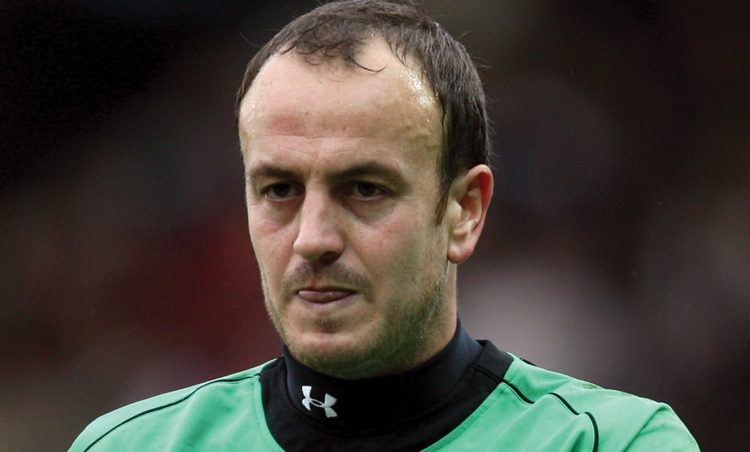




OUR BEST EVER OFFER - SAVE £100/$100
JOIN THE WORLD'S LEADING PROFESSIONAL DEVELOPMENT PROGRAMME
- 12 months membership of Elite Soccer
- Print copy of Elite Player & Coach Development
- Print copy of The Training Ground
You are viewing 1 of your 1 free articles
Switching play
Switching of play is a devastating and dynamic way of catching opposition players out of position, and this session takes the basic principles of switching before adding progressions and advancements in play so that teams can really utilise this attacking weapon.
| Area | Up to 40x40 yards |
| Equipment | Balls, cones, goals, mannequins |
| No. of Players | Up to 16 |
| Session Time | Passing drill and Transfer game 10mins each, Small-sided game 20mins |
Switching of play is a devastating and dynamic way of catching opposition players out of position, and this session takes the basic principles of switching before adding progressions and advancements in play so that teams can really utilise this attacking weapon.
We witness the benefit of switching in every game we play. And of course, examining its principles as an attacking team also helps us learn how to defend against the switch when in defensive mode.
What do I get the players to do?
Passing drill (1a)
In the left-hand practice, there is a blue server at each end of the box, and a blue on each mannequin in the middle. The ball is played in from the top, moving clockwise with a diagonal pass towards the wing. The player must react to the pass and step back off the mannequin, ready to receive. Two-touch, the ball is then played on, before the move is repeated back in the other direction.
1a
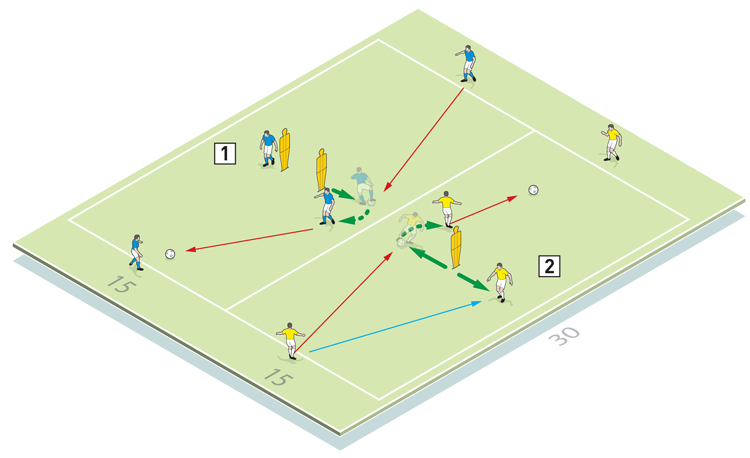
2. In the yellow box, both central players must be ready to receive a pass
In the second box, we position two players on a single mannequin. Now, the ball can go to either player, so both need to react to the potential of the pass. To progress, we restrict players to one-touch (1b).
1b
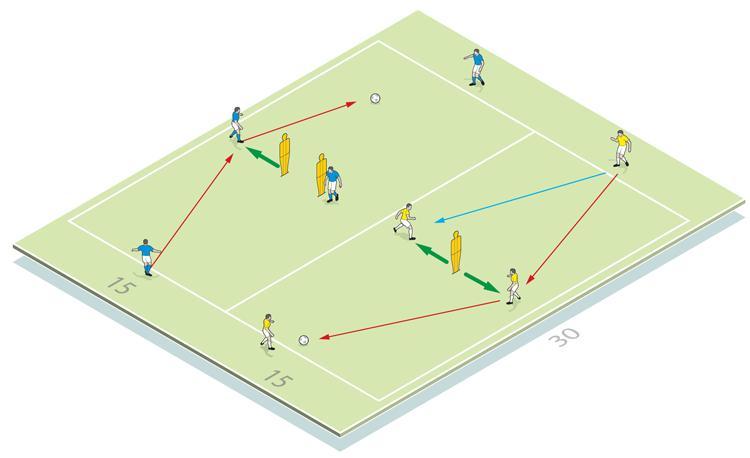
What are the key things to look out for?
Players must receive the ball on the back foot, side-on so they can see both servers. Movement off the mannequin must be realistic, with a sensible weight of pass from the server.
Transfer game
We now remove the poles and add a target player at each end, in a 5-yard zone (2a). It’s 6v6, with each team required to switch play to target players quickly. This is all-in, then reverts to two-touch, and there must be three passes before a pass is fed into a target player. Involving both target players in a move, uninterrupted, earns a point.
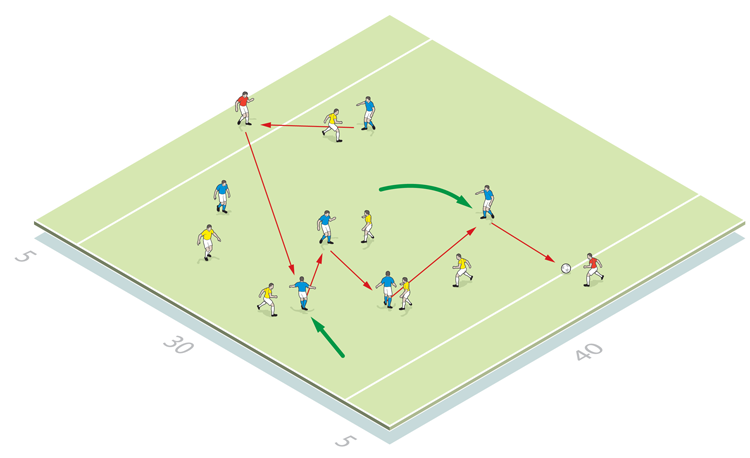
If play is turned over the new team in possession attacks (2b).
2b

What are the key things to look out for?
Players must recognise when they have space and time to turn. They need to create a picture in their heads before the ball arrives at their feet, something aided by good communication.
Small-sided game
We now switch direction of play by adding goals, as shown (3a).
3a
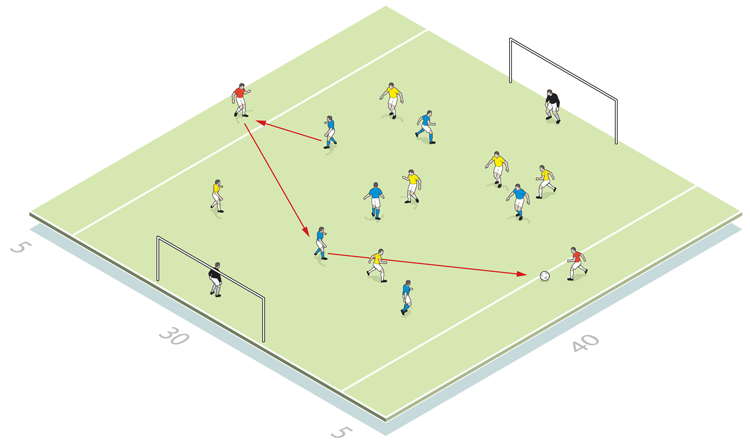
Target players no longer represent the scoring mechanism, but the switching mechanism, feeding the ball back into the middle to be attacked (3b).
Again, if the ball is transferred from one side to the other a point is earned, with two points for finding the net.
First this is two-touch, then remove wide areas and play 7v7, hoping players will still hold on to the principles of switching.
3b
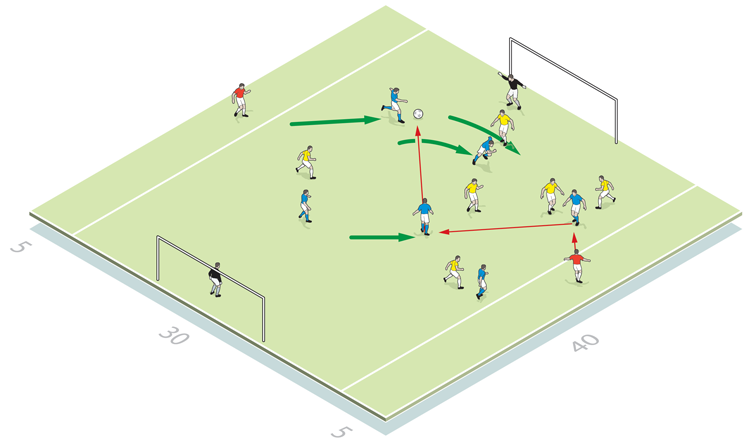
Related Files
Editor's Picks
Attacking transitions
Deep runs in the final third
Using the goalkeeper in build-up play
Intensive boxes drill with goals
Penetrating the final third
Creating and finishing
My philosophy
Pressing initiation
Compact team movement
Coaches' Testimonials

Alan Pardew

Arsène Wenger

Brendan Rodgers

Carlos Carvalhal

José Mourinho

Jürgen Klopp

Pep Guardiola

Roy Hodgson

Sir Alex Ferguson

Steven Gerrard
Coaches' Testimonials

Gerald Kearney, Downtown Las Vegas Soccer Club

Paul Butler, Florida, USA

Rick Shields, Springboro, USA

Tony Green, Pierrefonds Titans, Quebec, Canada
Join the world's leading coaches and managers and discover for yourself one of the best kept secrets in coaching. No other training tool on the planet is written or read by the calibre of names you’ll find in Elite Soccer.
In a recent survey 92% of subscribers said Elite Soccer makes them more confident, 89% said it makes them a more effective coach and 91% said it makes them more inspired.
Get Monthly Inspiration
All the latest techniques and approaches
Since 2010 Elite Soccer has given subscribers exclusive insight into the training ground practices of the world’s best coaches. Published in partnership with the League Managers Association we have unparalleled access to the leading lights in the English leagues, as well as a host of international managers.
Elite Soccer exclusively features sessions written by the coaches themselves. There are no observed sessions and no sessions “in the style of”, just first-hand advice delivered direct to you from the coach.
